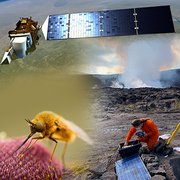Earthquakes Pose Risk to Global Mineral Supplies
USGS scientists study how seismicity could impact mineral commodity supplies like copper and rhenium.
Monitoring Kīlauea Volcano's Current Eruption
Eruptions within Hawaiʻi Volcanoes National Park have been intermittent since December 23, 2024.
Alarming Future for California's Coastline
Computer modeling and new research predict significant erosion by 2100.
Postfire Debris-Flow Hazard Assessments Help Manage Further Loss
This interactive dashboard shows the likelihood and potential severity for debris-flows.
Understanding Earth's Electrical Conductivity Helps Protect from Space Weather
The study can also help support mineral and geothermal resource assessment.
Rapid Response Seismometers Help Scientists Assess Hazards
Seafloor seismographs were quickly deployed following a major earthquake offshore Northern California.
New USGS-FEMA study highlights economic earthquake risk in the United States
Natural Hazards Mission Area
Every year in the United States, natural hazards threaten lives and livelihoods and result in billions of dollars in damage. We work with many partners to monitor, assess, and conduct targeted research on a wide range of natural hazards so that policymakers and the public have the understanding they need to enhance preparedness, response, and resilience.
Get Notified
You can subscribe to USGS Hazards Data Alerts, Forecasts and other Earth Monitoring Information






